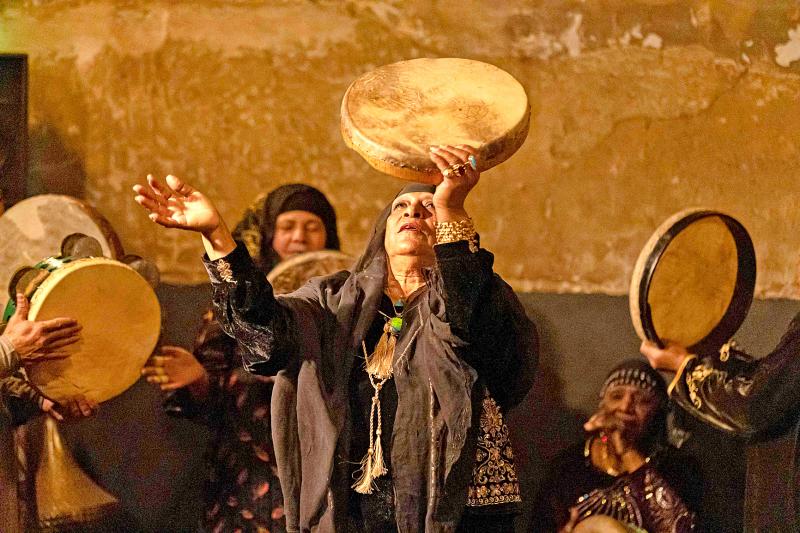It looks like a concert of Egyptian folk music — a stage, lights and a mesmerized audience — but Umm Sameh is singing to heal the sick by driving out the demons that possess them.
The music and dance ritual known as zar, with centuries-old roots in Ethiopia and Sudan, is traditionally performed to ward off or exorcise jinn or evil spirits.
“We’re not quacks or witches,” said Umm Sameh, aged in her 70s, with coal-lined eyes, large hoops in her ears and gold bracelets on her arms.

Photo: AFP
“The singing is spiritual and brings out negative energies,” the lead singer of the Mazaher ensemble said, adding that they also perform prayers from Islam’s mystic Sufi practices.
Traditionally, the zar ritual would last several days and include animal sacrifices, but no blood is spilled at Cairo’s Makan Cultural Center, where the group performs to the delight of foreign and local guests.
The audience members are bewitched by Umm Sameh’s voice and nod their heads to the drumbeat. In a patriarchal society where women face frequent discrimination, zar ceremonies are among the few cultural practices in which they take center stage.
Umm Sameh said she learned the ritual at the age of 11 from her mother and grandmother.
Six decades later, she recites the same lyrics to the same tunes — all from memory, she adds proudly, because she has “inherited them and grown up with them.”
“Zar is a very old healing ritual, a bit like medical treatment,” said Ahmed al-Maghraby, founder of Mazaher, which he says is Egypt’s last group to perform zar in public.
He set up the Makan performance space 22 years ago to “preserve this cultural heritage and archive local music from all over Egypt.”
It was a tough feat, he said, because zar has historically been derided by devout Muslims as a pagan practice, and rejected by modernizing state authorities as a backward rural tradition.
“Middle Eastern and Egyptian societies regard everything local with disgust,” al-Maghraby said, adding that it was foreign tourists who first brought Egyptians to the shows, who he remembered used to say: “No! There’s jinn and blood.”
“For them, the zar was always something sinful,” he added.
Ensemble member Abou Samra said that “people have a very negative idea of zar because of the movies” in Egypt, long regarded as the Hollywood of the Arab world.
In one of them, 1987 horror movie Al Taweeza (The Curse), superstars Youssra and Tahia Carioca contorted themselves, drenched in fake blood and emitting shrill cries.
However, zar is “an art like all other arts,” said Abou Samra, who plays the tanboura, a six-string lyre. “We have to let go of these stereotypes.”
Times are changing: The ensemble, whose musicians and dancers are all over the age of 60, have brought in a new member.
Azza Mazaher, who grew up watching her mother, Umm Hassan, do percussion, now drums and energizes the show as she dances across the stage.
Azza said that the group now performs in traditional and new ways.
“If someone feels sick and the doctors can’t find a treatment, we can hold a ceremony,” she said.
“But here, we’re performing a light piece of folklore, so people can discover it, understand it and enjoy it,” she added.
Mazaher has taken part in several European festivals, and more Egyptians are flocking to their Cairo performances, appreciative of the homegrown art form.
Mariam Essawi, an audience member in her 20s, said: “They look like us. They represent us. Zar is part of our history and our cultural heritage. It’s very strange that we don’t know it.”

The death of a former head of China’s one-child policy has been met not by tributes, but by castigation of the abandoned policy on social media this week. State media praised Peng Peiyun (彭珮雲), former head of China’s National Family Planning Commission from 1988 to 1998, as “an outstanding leader” in her work related to women and children. The reaction on Chinese social media to Peng’s death in Beijing on Sunday, just shy of her 96th birthday, was less positive. “Those children who were lost, naked, are waiting for you over there” in the afterlife, one person posted on China’s Sina Weibo platform. China’s

‘NO COUNTRY BUMPKIN’: The judge rejected arguments that former prime minister Najib Razak was an unwitting victim, saying Najib took steps to protect his position Imprisoned former Malaysian prime minister Najib Razak was yesterday convicted, following a corruption trial tied to multibillion-dollar looting of the 1Malaysia Development Berhad (1MDB) state investment fund. The nation’s high court found Najib, 72, guilty on four counts of abuse of power and 21 charges of money laundering related to more than US$700 million channeled into his personal bank accounts from the 1MDB fund. Najib denied any wrongdoing, and maintained the funds were a political donation from Saudi Arabia and that he had been misled by rogue financiers led by businessman Low Taek Jho. Low, thought to be the scandal’s mastermind, remains

‘POLITICAL LOYALTY’: The move breaks with decades of precedent among US administrations, which have tended to leave career ambassadors in their posts US President Donald Trump’s administration has ordered dozens of US ambassadors to step down, people familiar with the matter said, a precedent-breaking recall that would leave embassies abroad without US Senate-confirmed leadership. The envoys, career diplomats who were almost all named to their jobs under former US president Joe Biden, were told over the phone in the past few days they needed to depart in the next few weeks, the people said. They would not be fired, but finding new roles would be a challenge given that many are far along in their careers and opportunities for senior diplomats can

Australian Prime Minister Anthony Albanese yesterday announced plans for a national bravery award to recognize civilians and first responders who confronted “the worst of evil” during an anti-Semitic terror attack that left 15 dead and has cast a heavy shadow over the nation’s holiday season. Albanese said he plans to establish a special honors system for those who placed themselves in harm’s way to help during the attack on a beachside Hanukkah celebration, like Ahmed al-Ahmed, a Syrian-Australian Muslim who disarmed one of the assailants before being wounded himself. Sajid Akram, who was killed by police during the Dec. 14 attack, and